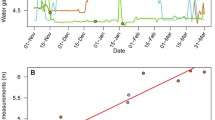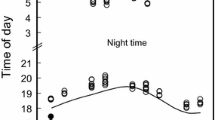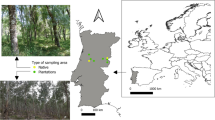Abstract
Ecosystems in the sub-Antarctic region can be subjected to extreme weather conditions year-round. Little data exist that show any relationship between climatic variables and activity patterns of passerine birds, despite the fact that weather patterns can have a dramatic influence on the foraging strategies of these birds in different seasons. Passerine birds must balance the risk of starvation and the risk of predation in accordance with variation in environmental variables. The goal of this study was to determine the relationship of season, habitat type and weather patterns with the daily activity patterns of three diurnal passerine bird species from different trophic guilds. Unlike most low-latitude passerine species, the three passerine bird species in Omora Park on Navarino Island do not show strict adherence to a bimodal activity pattern; instead, these birds show a variety of activity patterns throughout the year that differ by trophic guild and habitat type. These modifications in activity patterns may be an adaptation to minimize the risk of predation and starvation in the face of temperature-dependent food availability.





Similar content being viewed by others
References
Anthony RM, Barten NL, Seiser PE (2000) Foods of arctic foxes (Alopex lagopus) during winter and spring in western Alaska. J Mammal 81:820–828
Aschoff J (1966) Circadian activity pattern with two peaks. Ecology 47:657–662
Avery MI, Krebs JR (1984) Temperature and foraging success of great tits Parus major hunting for spiders. Ibis 126:33–38
Barlow J, Peres CA (2004) Avifaunal responses to single and recurrent wildfires in Amazonian forests. Ecol Appl 14:1358–1373
Bas JM, Pons P, Gómez C (2007) Daily activity of Sardinian warbler Sylvia melanocephala in the breeding season. Ardeola 54:335–338
Bednekoff PA, Houston AI (1994) Avian daily foraging patterns: effects of digestive constraints and variability. Evol Ecol 8:36–52
Bibby C, Martin J, Marsden S (1998) Bird surveys: expedition field techniques. Expedition Advisory Centre of theRoyal Geographic Society, London
Blake JG, Loiselle BA (2001) Bird assemblages in second-growth and old-growth forests, Costa Rica: perspectives from mist nets and point counts. Auk 118:304–326
Blake JG, Loiselle BA (2009) Species composition of Neotropical understory bird communities: local versus regional perspectives based on capture data. Biotropica 41:85–94
Bonter DN, Brooks EW, Donovan TM (2008) What are we missing with only ground-level mist nets? Using elevated nets at a migration stopover site. J Field Ornithol 79:314–320
Boyes RS, Perrin MR (2010) Patterns of daily activity of Meyer’s Parrot (Poicephalus meyeri) in the Okavango Delta, Botswana. Emu 110:54–65
Brandt MJ, Cresswell W (2009) Diurnal foraging routines in a tropical bird, the rock finch Lagonosticta sanguinodorsalis: How important is predation risk? J Avian Biol 40:90–94
Brown CE, Anderson CB, Ippi S, Sherriffs MF, Charlin R, McGehee S, Rozzi R (2007) The autecology of the fío-fío (Elaenia albiceps Lafresnaye and d’Orbigny) in subantarctic forests of the Cape Horn Biosphere Reserve, Chile. An Inst Patagon 35:29–40
Burger J (1976) Daily and seasonal activity patterns in breeding Laughing Gulls. Auk 93:308–323
Cameron M (2005) Group size and feeding rates of Glossy black-cockatoos in central New South Wales. Emu 105:299–304
Cimprich D, Woodrey M, Moore F (2005) Passerine migrants respond to variation in predation risk during stopover. Anim Behav 69:1173–1179
Cresswell W, Clark JA, Macleod R (2009) How climate change might influence the starvation–predation risk trade-off response. Proc R Soc B 276:3553–3560
Dann S, Aschoff J (1975) Circadian rhythms of locomotor activity in captive birds and mammals: their variations with season and latitude. Oecologia 18:269–316
Derlindati EJ, Caziani SM (2005) Using canopy and understory mist nets and point counts to study bird assemblages in Chaco forests. Wilson Bull 117:92–99
Gilardi JD, Munn CA (1998) Patterns of activity, flocking and habitat use in parrots of the Peruvian Amazon. Condor 100:641–653
Goodall JD, Johnson AW, Philippi RA (1951) Las Aves de Chile, su conocimiento y sus costumbres. Platt Establecimientos Gráficos, Buenos Aires
Houston A, McNamara JM, Hutchinson JMC (1993) General results concerning the trade-off between gaining energy and avoiding predation. Proc Roy Soc Lond B 341:375–397
Hutto RL (1981) Temporal patterns of foraging activity in some wood warblers in relation to the availability of insect prey. Behav Ecol Sociobiol 9:195–198
Ippi S, Anderson CB, Rozzi R, Elphick C (2009) Annual variation of abundance and composition in forest bird assemblages on Navarino Island, Cape Horn Biosphere Reserve, Chile. Ornitol Neotrop 20:231–245
Jacquet JM, Launay F (1997) Diurnal behavioural patterns in the Houbara Bustard (Chlamydotis undulata) in captivity: effects of temperature and day length. Appl Anim Behav Sci 55:137–151
Jiménez JE (2000) Effect of sample size, plot size, and counting time on assessment of avian diversity and abundance in a Chilean rainforest. J Field Ornithol 71:66–88
Karr JR (1981) Surveying birds with mist nets. Stud Avian Biol 6:62–67
Latta SC, Tinoco BA, Astudillo PX, Graham CH (2011) Patterns and magnitude of temporal change in avian communities in the Ecuadorian Andes. Condor 113:24–40
Lees J (1948) Winter feeding hours of robins, blackbirds and blue tits. Br Birds 41:71–76
Lewis T, Taylor LR (1964) Diurnal periodicity of flight by insects. T Roy Ent Soc Lond 116:393–476
Liebezeit JR, Zack S (2008) Point counts underestimate the importance of Arctic foxes as avian nest predators: evidence from remote video cameras in Arctic Alaskan oil fields. Arctic 61:153–161
Lima SL (1988) Initiation and termination of daily feeding in dark-eyed juncos: influence of predation risk and energy reserves. Oikos 53:3–11
Low M, Eggers S, Arlt D, Pärt T (2008) Daily patterns of nest visits are correlated with ambient temperature in the Northern Wheatear. J Ornithol 149:515–519
MacLeod R, Gossler AG, Cresswell W (2005a) Diurnal mass gain strategies and perceived predation risk in the great tit Parus major. J Anim Ecol 74:956–964
MacLeod R, Barnett P, Clark JA, Cresswell W (2005b) Body mass change strategies in blackbirds Turdus merula: the starvation-predation risk trade-off. J Anim Ecol 74:292–302
Martínez D, González G (2004) Las aves de Chile: Nueva guía de campo. Ediciones del Naturalista, Santiago
Maruyama PK, Cunha AF, Tizo-Pedroso E, Del-Claro K (2010) Relation of group size and daily activity patterns to southern lapwing (Vanellus chilensis) behaviour. J Ethol 28:339–344
McGehee SM, Eitniear JC (2007) Diet of the Patagonian Sierra-finch (Phrygilus patagonicus) on Navarino Island, Chile. Ornitol Neotrop 18:449–452
McGehee SM, Rozzi R, Anderson C, Ippi S, Vásquez R, Woodland S (2004) Late-summer presence of the Patagonian tyrant Colorhamphus parvirostris (Darwin) on Navarino Island, Cape Horn County, Chile. An Inst Patagon 32:25–33
McNamara JM, Houston AI, Lima SL (1994) Foraging routines of small birds in winter-a theoretical investigation. J Avian Biol 25:287–302
McNamara JM, Barta Z, Wikelski M, Houston AI (2005) A theoretical investigation of the effect of latitude on avian life histories. Am Nat 172:331–345
Møller AP, Rubolini D, Lehikoinen E (2008) Populations of migratory bird species that did not show a phenological response to climate change are declining. Proc Natl Acad Sci USA 105:16195–16200
Morton ML (1967a) Diurnal feeding patterns in white-crowned sparrows Zonotrichia leucophrys gambelii. Condor 69:491–512
Morton ML (1967b) The effects of insolation on the diurnal feeding pattern of white-crowned sparrows (Zonotrichia leucophrys gambelii). Ecology 48:690–694
Newton I (1998a) Inter-specific competition. In: Newton I (ed) Population limitation in birds. Academic Press, San Diego, pp 319–352
Newton I (1998b) Predation. In: Newton I (ed) Population limitation in birds. Academic Press, San Diego, pp 211–244
Parrish JD (1997) Patterns of frugivory and energetic condition in Nearctic landbirds during autumn migration. Condor 99:681–697
Pepper JW, Male TD, Roberts GE (2000) Foraging ecology of the South Australian Glossy black-cockatoo (Calyptorhynchus lathami halmaturinus). Austral Ecol 25:16–24
Pizo MA, Simão I (1997) Daily variation in activity and flock size of two parakeet species from southeastern Brazil. Wilson Bull 109:343–348
Polo V, Bautista LM (2006) Daily routines of body mass gain in birds: 1. An exponential model. Anim Behav 72:503–516
Quinn G, Keough M (2002) Experimental design and data analysis for biologists. Cambridge University Press, Cambridge
Remsen JV Jr, Good DA (1996) Misuse of data from mist-net captures to assess relative abundance in bird populations. Auk 113:381–398
Ricklefs RE, Hainsworth ER (1968) Temperature dependent behavior of the Cactus wren. Ecology 49:227–233
Robbins CS (1981) Effect of time of day on bird activity. Stud Avian Biol 6:275–286
Rozzi R, Massardo F, Silander J Jr, Anderson C, Dollenz O, Marin A (2003) El Parque Etnobotánico Omora: una alianza público–privada para la conservación biocultural en el confín del mundo. Ambiente y Desarrollo 19:43–55
Rozzi R, Massardo F, Anderson C, Heidinger K, Silander J Jr (2006) Ten principles for biocultural conservation at the southern tip of the Americas: the approach of the Omora Ethnobotanical Park. Ecol Soc 11:43
Rozzi R, Anderson CB, Pizarro JC, Massardo F, Medina Y, Mansilla A, Kennedy JH, Ojeda J, Contador T, Morales V, Moses K, Poole A, Armesto JJ, Kalin MT (2010) Field environmental philosophy and biocultural conservation at the Omora Ethnobotanical Park: methodological approaches to broaden the ways of integrating the social component (“S”) in Long-Term Socio-Ecological Research (LTSER) Sites. Rev Chil Hist Nat 83:27–68
Rozzi R, Armesto JJ, Gutiérrez J, Massardo F, Likens G, Anderson CB, Poole A, Moses K, Hargrove E, Mansilla A, Kennedy JH, Willson M, Jax K, Jones CG, Callicott JB, Arroyo MTK (2012) Integrating ecology and environmental ethics: earth stewardship in the southern end of the Americas. Bioscience 62:226–236
Salinas-Melgoza A, Renton K (2005) Seasonal variation in activity pattern of juvenile Lilac-crowned Parrots in tropical dry forest. Wilson Bull 117:291–295
Schoech SJ, Hahn TP (2008) Latitude affects degree of advancement in laying by birds in response to food supplementation: a meta-analysis. Oecologia 157:369–376
Skirvin AA (1981) Effect of time of day and time of season on the number of observations and density estimates of breeding birds. Stud Avian Biol 6:271–274
Spaulding RL, Krausman PR, Ballard WB (1998) Summer diet of Gray Wolves, Canis lupus, in northwestern Alaska. Can Field Nat 112:262–266
Suthers HB, Bickal JM, Rodewald PG (2000) Use of successional habitat and fruit resources by songbirds during autumn migration in central New Jersey. Wilson Bull 112:249–260
Terborgh J, Robinson SK, Parker TA III, Munn CA, Pierpont N (1990) Structure and organization of an Amazonian forest bird community. Ecol Monogr 60:213–238
Trnka A, Prokop P (2006) Do predators cause a change in passerine movement patterns as indicated by mist-net trapping rates? Ardea 94:71–76
Trnka A, Szinai P, Hošek V (2006) Daytime activity of reed passerine birds based on mist-netting. Acta Zool Acad Sci Hung 52:417–425
Yom-Tov Y, Geffen E (2011) Recent spatial and temporal changes in body size of terrestrial vertebrates: probable causes and pitfalls. Biol Rev 86:531–541
Zakaria M, Rajpar MN (2010) Bird species composition and feeding guilds based on point count and mist netting methods at the Paya Indah Wetland Reserve, Peninsular Malaysia. Trop Life Sci Res 21:7–32
Acknowledgments
Our sincere thanks to Ximena Arango, Steven McGehee, Cristian Celis, Rodrigo Molina, and the many students and volunteers of Omora Park for their collaboration in the bird captures. This work was supported by the Long Term Socio-Ecological Research (LTSER) of the Institute of Ecology and Biodiversity (IEB) and funded by IEB and PBCT 29800 postdoctoral fellowship, CONICYT and Universidad de Magallanes, to the first author. This work is part of the FPA project “Fortalecimiento del Observatorio Omora de Aves Subantárticas en la Reserva de Biósfera Cabo de Hornos,” supported by Ministerio del Medio Ambiente, Chile.
Author information
Authors and Affiliations
Corresponding author
Rights and permissions
About this article
Cite this article
Reyes-Arriagada, R., Jiménez, J.E. & Rozzi, R. Daily patterns of activity of passerine birds in a Magellanic sub-Antarctic forest at Omora Park (55°S), Cape Horn Biosphere Reserve, Chile. Polar Biol 38, 401–411 (2015). https://doi.org/10.1007/s00300-014-1596-5
Received:
Revised:
Accepted:
Published:
Issue Date:
DOI: https://doi.org/10.1007/s00300-014-1596-5




